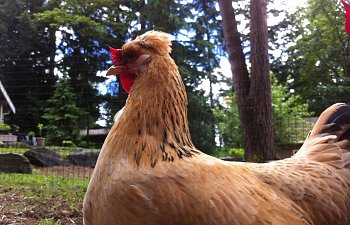Meet the Valhalla Homestead Icelandic Chickens!
Say "halló" (“hello” in Icelandic) to our happy little preservation flock of Icelandic Chickens! They live on our Western Washington homestead where they typically get to free-range and scratch around the yard and compost pile to their heart’s content all day long. These liberty-loving birds came to us from the Icelandic farms of Hlésey and Húsatóftir, which are owned by long-time breeders of Icelandic chickens in Iceland. When I write this my own direct import* from Húsatóftir farm in Iceland has not yet hatched, but below are pictures of the birds we have from the Hlésey line. I'll post pictures of the Húsatóftir birds shortly, they are due to hatch in early August
(*Done with USDA permits and fully certified and inspected by the proper authorities in the US and Iceland.)
For those not familiar with the Icelandic chickens they are a rare 1100-year old landrace breed from Iceland. Some call them Viking chickens, or Icelandic Settlement Chickens. Us Icelanders call them Landnámshænsn or Landnámshænur (which means “settlement chickens”) and also íslenskar hænur or íslenska hænsnakynið (which means “Icelandic hens/chickens”). A few old timers call them Haughænsn (which means “pile chickens”) 'cause they LOVE to free-range and dig in compost piles. This breed was brought to Iceland by Viking seafaring settlers around the year 900 A.D. and have been isolated there with minimal mixing ever since, preserving their ancient heritage. Genetic tests have shown the breed to be substantially different from modern breeds (over 70% difference), with a great deal of unique genetic diversity. They are a true Old World treasure!
The Icelandic chicken is a very hardy, healthy breed with a natural curiosity and love for foraging. The hens readily go broody and do a great job at raising their own chicks, making them an ideal backyard or homestead breed. They are generally calm-natured, fun, and friendly, but can run very fast when they don't want to be picked up.
Size-wise, the Icelandic chicken is a well-built medium sized bird, although often on the smaller side of medium. It is larger than a bantam, but not by a great deal. However, the hens lay a generous amount of medium to large eggs that have beautiful white to cream-colored shells.
The Icelandic chicken is a landrace and comes in a wide variety of colors and several varieties of combs, although the most common comb is the single comb, followed by the rose comb, although other combs are possible. Offspring may or may not have the coloring of their parents. Their uniqueness comes from their ancient genetics, which is why birds must be kept 100% pure to be considered "Icelandic". If they are ever mixed they can never be bred back to being Icelandic. This is why it is very important to keep track of your bloodlines if you want to raise pure Icelandics.
Here are my Hlésey birds. The roo's name is Prímus (a silver duck-wing), and his girls are Kara (buff columbian colored), Sirrí (all blue) and Skráma, (blue with a brown collar). Pictures were taken when they were around 6-7 months of age:
Here is a picture of my Hlésey hatch at 6 weeks of age. I got 6 roosters and 3 hens so 5 of the roosters have been re-homed with a very select group of breeders and farmers.
The rooster we let go of last was our black beauty, Glámur. He is currently providing pasture security for a flock of over 20 free-ranging hens at a friends' farm and doing an excellent job. This is a picture of him at 6 months of age:
Here is a picture of the first chicks of of my August Hlésey-line hatch. These are chicks from Sirrí and Kara, sired by Glámur and/or Prímus:
Thank you for reading!
If you have questions, please feel free to send me a message, my BYC username is "Icelander" or send an email to vala**at**icelandicchickens.com
RESOURCES:
- Home page of Hlésey farm owned by Jóhanna Harðardóttir http://www.hlesey.is/
- Some basic statistics and information about the Icelandic Chicken can be found on website for the United Nations Food and Agriculture Organization's AvianDiv project at http://aviandiv.tzv.fal.de/ Select "database", then select "breed information", and then select "Icelandic landrace". Please note that the egg color is incorrect, pure Icelandic chickens mostly lay white and cream eggs, some may lay very light brown or beige eggs they are never dark enough to properly classify as a brown egg.
- A really great interview (and lots of pictures) with the lovely Jóhanna Harðardóttir, the owner of Hlésey farm and the founder and first president of the Icelandic Owners and Breeders Association in Icelandi can be found at http://aviculture-europe.nl/nummers/10E06A03.pdf There are a few possible errors, such as that Iceland does allow some poultry imports (I was told by a staff member of the Icelandic Veterinary Authority that meat-bird eggs are shipped from Sweden regularly) and we do import dogs etc. but they have to stay 4 weeks in isolation. Also, I am not sure it's correct that the birds are never monochromatic or that they lay eggs that are often on the smaller side of medium.

